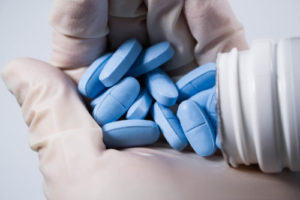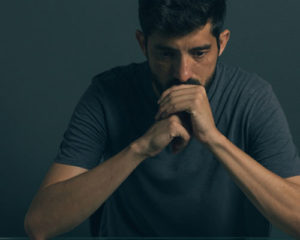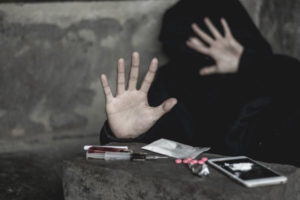Halcion is a strong prescription medication that the U.S. Food and Drug Administration has approved for the short-term treatment of insomnia. A week to 10 days is considered to be a safe duration of Halcion use.
Any use beyond three weeks requires a full patient reevaluation, even if a doctor initially prescribed Halcion. Because of the high risk of developing a dependence on the medication, it is strongly advised not to take Halcion for more than one month.
Halcion, also available under the generic name triazolam, is from the benzodiazepine class of drugs. Benzodiazepines are central nervous system (CNS) depressants that work by calming the nervous system. This makes them very effective at calming anxieties so someone with insomnia can sleep better, but it also makes them dangerous to use recreationally or in high doses. Overuse of benzodiazepines can cause dangerous levels of respiratory depression, as well as coma and even death.
Halcion Use and Abuse
Halcion is meant to be only obtained and consumed through a doctor’s prescription. Doctors can individualize dosages to achieve optimal effects. They also can help monitor the development of tolerance and dependence on the drug. Customizing dosage amounts helps to maximize the intended benefits of the drug while minimizing the chances of experiencing adverse side effects.
Most adults respond well to a dose of 0.25 mg (milligrams) before going to bed. Some people may even only need a dose of 0.125 mg to achieve a full night’s sleep of seven to eight hours. A dose of 0.5 mg is considered strong and should be reserved for cases when no response is felt after trying a lower dose first. Experts highly recommend not exceeding doses of 0.5 mg.
Halcion abuse often occurs when people want to self-medicate their anxiety and insomnia or when people use prescription medications, like benzodiazepines, recreationally. When you attempt to self-medicate with Halcion or experiment with it recreationally, the ability to individualize optimal dosages goes down, and your risk of overdose goes up.

Prescription drug abuse has become a major problem across the United States. Easy access to prescription medications and relative affordability have led to widespread abuse. Prescription drug abuse is defined by the following:
- Taking higher doses than instructed
- Taking medicines that were not prescribed for you
- Consuming medicines in ways that you aren’t meant to, such as snorting the drug
- Using medicines to get high rather than to treat medical problems
It is possible to abuse Halcion in all of the above ways. People who abuse prescription drugs often assume they are safe because doctors prescribe them. When taken without a doctor’s supervision, however, safe doses cannot be assured, and the occurrence of negative side effects cannot be monitored.
Common Side Effects
Like any prescription medication, side effects are commonly observed in people who take Halcion. Side effects often affect the central nervous system as well as the gastrointestinal system. They include:
- Drowsiness
- Headache
- Dizziness
- Nervousness
- Lightheadedness
- Impaired physical coordination
- Nausea
- Vomiting
The above side effects are considered common and usually resolve on their own. As your body develops a tolerance to Halcion, it learns how to process the medication better, and the experience of adverse side effects usually subsides. If not, you might be able to take other medications to address mild symptoms such as a headache. Always speak with your doctor first, however, before mixing medications.
Serious Side Effects
In addition to the range of commonly experienced side effects with Halcion use, there are less common but more severe side effects that can occur. It is important to be aware of these more serious side effects so that they can be addressed as soon as they start to occur:
- Rapid or irregular heartbeat
- Cognitive impairment
- Visual hallucinations
- Skin rash
- Muscle weakness
- Numbness, tingling, or burning sensations
- Nightmares
- Insomnia
- Slurred speech
- Jaundice
- Swelling of the eyes, face, lips, tongue, or throat
- Difficulty breathing or swallowing
Side effects are likely to be more severe if you are taking Halcion in conjunction with other drugs. Alcohol and opioids, for example, can significantly increase the severity of adverse side effects. The occurrence of any of the above side effects could indicate an allergic reaction or an overdose.
If you begin to experience any of these symptoms, call your doctor or emergency medical help right away. An overdose must be addressed with immediate medical attention.
Halcion Warnings
In addition to the above side effects, Halcion use comes with specific warnings. One of the greatest warnings is to be extremely careful about which drugs you mix with Halcion. Using Halcion at the same time that you use other benzodiazepines, opioids, or alcohol can be very dangerous. All of these substances are central nervous system depressants. When consumed together, they can cause dangerous levels of central nervous system depression.
Benzodiazepines alone rarely cause overdose, but when taken alongside opioids or alcohol, impaired breathing, coma, and death are possible. Halcion can also interact poorly with many other prescription medications, so it is important to let your doctor know about all medications you are taking before starting to use Halcion. People with certain pre-existing medical conditions are also warned against using Halcion.
Benzodiazepines are also known to be dangerous for pregnant and nursing women. The medications can enter a baby’s system while the mother is pregnant and cause withdrawal symptoms in the baby after birth. It is also believed that Halcion enters breast milk, so it should not be used by mothers who are still nursing their babies.
Children under age 18, as well as adults older than age 65, are advised to use Halcion with extreme caution. It is best to use alternative methods of treating anxiety and insomnia for these groups, as the effects of Halcion use are not yet fully understood. Elderly patients typically have slower metabolisms, so if Halcion must be used, it is recommended to begin with very low doses.
If you are taking Halcion, it is important to monitor your symptoms, dosages, and personal response to the drug. Be alert to your experience of any dangerous side effects as well as the development of tolerance to or dependence on the medication.
How To Know When Halcion Is Cut
How is it possible to know when Halcion has been cut with other drugs? The easiest way is to make sure to always purchase the medication from a licensed and established pharmacist who will not sell the drug without a valid prescription from a doctor.
As a benzodiazepine, Halcion is a Schedule IV substance in the United States. This means that while there is a moderate risk of the drug causing physical or psychological dependence in users, the medical benefits outweigh the potential dangers.
This also means that legally obtained Halcion goes through enough checks and processes to ensure that it is not mixed with any other substances.
Halcion obtained illegally, however, comes with no such guarantees. Pills bought online or via an unlicensed dealer can easily be laced with other drugs to give the appearance of being legitimate Halcion.
In cases of online pharmacies offering fake benzodiazepines, the Food and Drug Administration warns users not to trust sellers who offer Halcion without requiring a doctor’s prescription or who offer discounts and prices that are too good to be true. Any seller making such promises is likely offering Halcion that is either illegally obtained or laced with another substance as that dealer’s way of cutting their costs.
Signs of Addiction
People can become addicted to Halcion following a history of medical and recreational use of the drug. Mild euphoria, relaxation, and sedation are a few reasons why someone might use Halcion recreationally. Fairly quickly after beginning use, however, a tolerance to the drug begins to develop.
Tolerance occurs following the continued use of a drug. The body adapts to the drug in the system and learns how to metabolize it more efficiently. As a result, the same dose no longer gives you the same desired effects. In response to tolerance, you can increase your dosage to achieve the desired effects of the drug once again. In time, however, your body will also develop a tolerance for that dosage level. 
It is important to be clear that tolerance does not mean the same thing as addiction. Tolerance is merely the body’s physiological response to the drug, and it is a normal response. Concerns arise, however, when tolerance progresses to dependence.
In the case of dependence, you will experience physical and psychological symptoms when you attempt to stop using the drug. These symptoms, known as withdrawal symptoms, can range in intensity from mild to severe. If you have been taking Halcion for an extended period and experience withdrawal symptoms when you attempt to cut back or stop using the drug, you have developed dependence.
As with all forms of benzodiazepine dependence, medical supervision is needed to safely withdraw from Halcion. Benzodiazepine detox can come with life-threatening withdrawal symptoms, so medical detox is absolutely required.
Like tolerance, dependence is also not the same thing as addiction, though it is often a precursor to addiction forming. Addiction is a disease of the brain where control over drug use is lost. All you can think about is using the drug, and you are not able to stop using the drug even when you really want to. Additional signs of benzodiazepine addiction include:
- Tolerance to the medication has developed.
- You have been taking larger and larger doses.
- You have a persistent urge to keep taking the medication.
- You continue to abuse the medication despite suffering negative consequences.
- You become consumed with obtaining the medication from whatever sources you can.
- You frequently run out of your prescription.
- You self-medicate anxiety and insomnia on a regular basis.
- You can’t function or sleep without the medication.
- You experience withdrawal symptoms when you attempt to stop taking the medication.
If the above are true for you, you may be struggling with benzodiazepine abuse, and it could be time to seek treatment. Begin by speaking with your doctor who can assess the severity of your situation. Your doctor should be well informed about prescription drug abuse and can make referrals for appropriate treatment options.
Halcion Withdrawal Timeline
How long will Halcion withdrawal take? The duration is determined by several factors related to how long the medication was used and how much was consumed and the person’s unique physiology (their general and mental health condition, any genetic factors, and whether other drugs were being consumed at the same time).
 Recommended Halcion doses are usually 0.25 mg (milligrams), to be taken before going to bed. A 0.5 mg dose is meant only for patients who do not respond to lower doses. No doctor will ever prescribe more than 0.5 mg of Halcion because every increment of the medication raises the possibility of adverse reactions, including tolerance and addiction.
Recommended Halcion doses are usually 0.25 mg (milligrams), to be taken before going to bed. A 0.5 mg dose is meant only for patients who do not respond to lower doses. No doctor will ever prescribe more than 0.5 mg of Halcion because every increment of the medication raises the possibility of adverse reactions, including tolerance and addiction.
In overall terms, the first physical symptoms of Halcion withdrawal will occur within six to 24 hours of the last dose.
These symptoms will include nausea, headaches and muscle pain, which will last for upward of a week. To ease the process, a patient should not discontinue their Halcion consumption cold turkey; instead, they should be carefully weaned off their need for the medication. If this is done in a medical setting, a doctor can administer other medications to provide relief from the symptoms.
It can take about two weeks for the physical symptoms to reach their peak before they begin to decline. However, there are psychological symptoms, including insomnia, that will persist if they are not addressed via counseling and further medication. This stage of addiction treatment will involve ongoing therapy, group meetings, peer support, and outpatient care. If applied consistently, the psychological symptoms of Halcion withdrawal will likely subside within six to 12 months of the medication’s discontinuation.
Addiction Treatment Options
Facing a prescription drug addiction can be intimidating, but the good news is there are many treatment options available. Based on your goals for treatment, you can select from a variety of rehab programs.
Typically, substance use disorders are treated most effectively through comprehensive treatment programs. Addiction treatment programs that are effective for prescription drug abuse problems include:
Outpatient treatment
Clients visit a behavioral health center, clinic, hospital, or doctor’s office to receive behavioral and drug abuse treatment services. They continue to live at home while receiving treatment.
Inpatient treatment
Clients enroll in a residential program where they live on site and receive the highest levels of support and structure for addiction recovery.
Whether you decide to enroll in an outpatient or inpatient treatment program, you can expect to receive comprehensive addiction treatment. According to the National Institute on Drug Abuse (NIDA), there are specific facets that must be included in successful treatment programs.
- Detoxification
- Behavioral counseling
- Medication management, if applicable
- Evaluation and treatment of any co-occurring mental health disorders
- Establishment of a long-term follow-up and aftercare plan to prevent relapse
If all of the above components are successfully met, people should be able to stop using drugs, remain substance-free, and return to their daily lives as productive members of society. Overcoming a prescription drug addiction is a challenging process, but it can be accomplished by anyone given the right support.
Sometimes, relapse is part of the recovery process. It isn’t a sign that treatment has failed; it’s a sign that the treatment plan needs to be adjusted.
Can Halcion Be Used Safely?
Any time you use prescription medications for reasons other than their intended purposes, you are abusing the medicine and put yourself at risk for developing dependence and addiction. If you are using Halcion without the supervision of a doctor, be very careful about the potential risks you are facing.
Halcion can be used safely, as long as you remain very conscious about your use and use it only according to its prescription. If you stay in close communication with your doctor about both the positive and negative side effects you experience as a result of taking Halcion, you can greatly reduce your chances of developing complications that require further attention.

